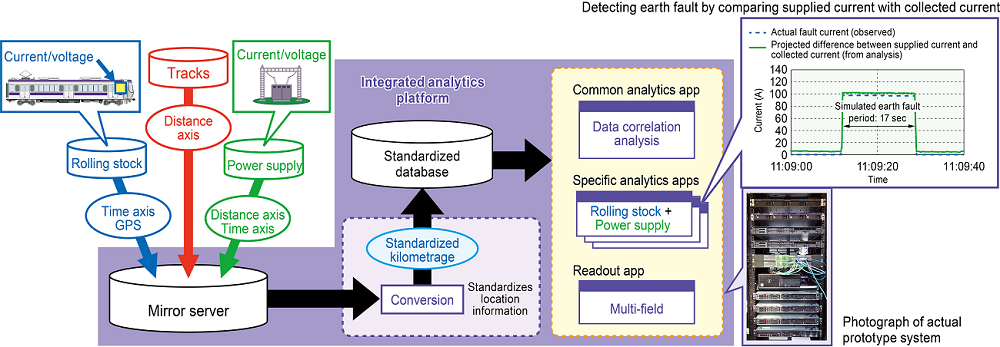9. Integrated analytics platform for railways
Maintenance data such as rolling stock, tracks and power systems is currently held in individual systems.
As railways are systems where these are interrelated, cross-sectional analysis using data from other systems is expected to efficiently identify the root causes of harmful alterations and design appropriate remedial strategies.
The problem has been, however, that different systems use differing data formats and measuring systems (particularly in terms of data precision and intervals between observations), not to mention different types of equipment and even different formats for expressing location information.
Our integrated analytics platform for railways aggregates and unifies maintenance data from differing systems to enable cross-sectional analytical studies across multiple systems.
The platform uses a standardized kilometrage format that distinguishes between up/down lines and main lines/passing tracks, and also recognizes discontinuities associated with track works, in order to enable seamless conversion of differing location information formats used by different systems.
We have also developed an analytical technique that uses multiple indicators to investigate relationships between different data sets. This technique can quickly and efficiently trawl through huge volumes of data aggregated from multiple systems to identify the location of any potential changes in equipment status.
In order to verify the functionality of the platform, we built a prototype system of the platform for use on the test track at the Institute (see Figure 1).
Using the prototype system, we demonstrated how maintenance data from multiple systems is automatically forwarded to the mirror server on the platform and converted into a common format for aggregation.
As an example, we set a simple scenario with one train and one substation, and demonstrated that data on current supplied by the substation and current collected in the train (in differing formats) could be successfully collated and used to detect an earth fault of approximately 100 A within just a few minutes.
Other Contents
- 9. Integrated analytics platform for railways
- 10. On-board obstacle detection system suitable for low-light conditions
- 11. Tool for estimating bridge deflection from on-board track irregularity measurements
- 12. Wear measuring apparatus for overhead conductor rail using light sectioning
- 13. Imaging analysis method for detecting various anomalies in overhead contact lines
- 14. Automated crew scheduling system
- 15. Fast-track embankment structure for confined settings
- 16. Numerical analysis method for predicting interaction impacts on closely adjacent tunnels
- 17. Method for evaluating girder vibration characteristics with consideration for track rigidity
- 18. Concrete repair methodology based on crack width and location
- 19. Using expansive concrete in track slabs to minimize reinforcement
- 20. Using temperature sensors to help predict service life of electronic signallingequipment
- 21. Effective and efficient steam weeding technique
- 9. Integrated analytics platform for railways
- 10. On-board obstacle detection system suitable for low-light conditions
- 11. Tool for estimating bridge deflection from on-board track irregularity measurements
- 12. Wear measuring apparatus for overhead conductor rail using light sectioning
- 13. Imaging analysis method for detecting various anomalies in overhead contact lines
- 14. Automated crew scheduling system
- 15. Fast-track embankment structure for confined settings
- 16. Numerical analysis method for predicting interaction impacts on closely adjacent tunnels
- 17. Method for evaluating girder vibration characteristics with consideration for track rigidity
- 18. Concrete repair methodology based on crack width and location
- 19. Using expansive concrete in track slabs to minimize reinforcement
- 20. Using temperature sensors to help predict service life of electronic signallingequipment
- 21. Effective and efficient steam weeding technique

